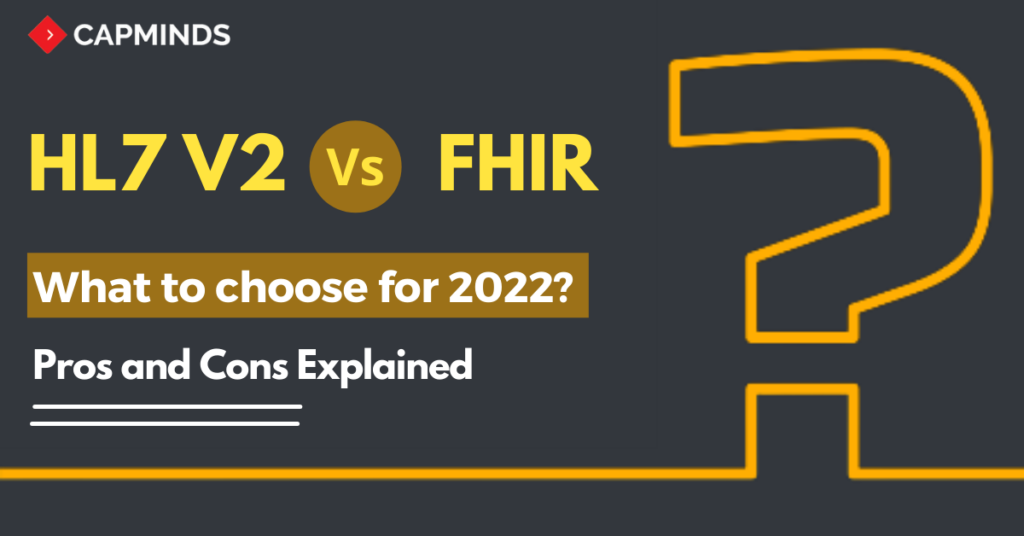HL7 V2 Vs FHIR (Pros & Cons) -What to Choose For 2022?
It’s not a secret that both HL7 and FHIR are important for achieving greater interoperability, but you need to decide where you should focus the most. Is an HL7 V2 or FHIR important more for your practice?
In this article, we will walk you through the pros and cons of HL7 V2 Vs FHIR, and give you the best ideas on what to choose for your practice in 2022.
We are now in the next wave of digital healthcare innovation which is reshaping the industry by delivering personalized care, integrated experience to patients, improving providers’ productivity, and more.
What is HL7 V2?
Released in the year 1989, HL7 V2 was the first healthcare information exchange standard, and also it is one of the most widely implemented throughout the world among other HL7 versions.
HL7 V2 works by providing a language for communication among various systems like EMR systems, laboratory information systems, medical billing systems, and more. These systems transmit ASCII text-based messages to one another in the situations like – when a doctor places a pharmacy order when a provider bills a patient when a patient is admitted to a hospital and more.
By creating the best ways for the systems to communicate, HL7 V2 has helped organizations to avoid complex software development work previously required to build interfaces.
Without clear specifications, HL7 V2 requires healthcare organizations to rely heavily on custom coding and the use of interface engines to achieve greater interoperability.
To overcome the limitations and challenges of HL7 version 2, instead of the loosely defined framework, HL7 V3 is a standard that predefines more of the interface. But due to lack of backward compatibility, substantial cost, and complex implementation, it has not been widely adopted.
In recent years, HL7 has introduced the Fast Health Interoperability Resource(FHIR®) standard which is more trending today in healthcare data-sharing platforms.
What is FHIR?
In the year 2014, HL7 introduced an alternative to HL7 V2 and V3 standards – the Fast Healthcare Interoperability Resources (FHIR) standard.
FHIR is an open standard that enables new applications to more easily exchange data than in the past. FHIR was not only developed to improve interoperability but also streamline implementation when compared with the previous HL7 standards.
FHIR builds on previous standards, including HL7 V2, HL7 V3, and CDA. But compared to other standards, HL7 FHIR employs RESTful web services and open web technologies including XML, JSON, and RDF data formats. As the developers are more familiar with these technologies, the need for understanding new technologies will be ultimately reduced when compared to other standards.
READ MORE: WHAT IS FHIR? WHY HOSPITALS SHOULD CARE?
HL7 V2 Vs FHIR: Pros & Cons
1. Event-based messaging
Similar to HL7 V2, FHIR also supports an event-based messaging paradigm. Comparing both, unlike version 2, FHIR supports some other paradigms including documents, REST, and other services models.
2. Extensibility
HL7 v2 provides an extensibility mechanism through the use of “Z-segments” – opaque without prior manual explanation by the sender. On the other hand, the FHIR extensions can appear at any level including within the data types. The meaning of FHIR extensions is discoverable by resolving the URI that defines the extension.
RELATED: THE REMARKABLE BENEFITS OF HL7 INTERFACE
3. Unfinished structure
HL7 version 2’s ‘’segment’’ structure roughly corresponds to FHIR’s idea of ‘’ resources’’. However, HL7 v2 segments can’t be independently manipulated. But FHIR has a different approach here. Due to these differences in the importance and approach to extensibility, the version 2 segments and data types are frequently messy with data elements. So they are not widely used or even understand by the implementations.
4. Inter-version compatibility
HL7 version 2 has complex processes for maintaining forward and backward compatibility. Content can only be added to the end of existing fields, components, etc. Applications are expected to ignore unexpected content or repetitions.
But, FHIR promises similar compatibility rules. The path to an element within an FHIR instance will remain unchanged in future versions.
5. Limitations in elements
Both of the HL7 versions – HL7 V2 and FHIR provide a similar level of flexibility at the international standard level. However, there are some great differences:
FHIR resources are more limited in terms of what elements are included in the core specification – only those elements that the vast majority of systems will support. HL7 v2 tends to include many elements that are used in only very limited circumstances.
6. Defining profiles
Both HL7 v2 and FHIR provide formal mechanisms for defining profiles to give guidance on the specification use. However, the HL7 v2 mechanism has not been widely used.
7. Human Readability
The HL7 v2 instances do not provide human-readable versions of the exchanged content. While some systems may make use of NTE segments – FHIR requires human-readable content to be provided for each resource.
HL7 V2 Vs FHIR: What to choose?
Comparing HL7 Vs FHIR, Fast Healthcare Interoperability Resources is a new specification and the latest version of HL7 that can be used as a stand-alone data exchange standard. FHIR is the up-to-date framework of healthcare information exchange, specially designed based on the needs of digital interactions.
The benefits of FHIR holds information sharing simplifies the implementation process and supports mobile applications.
- The physicians can easily share patient data among the care team members to speed up the decision-making process.
- FHIR benefits providers to offer timely and coordinated care for their patients
- Payers can exchange claims data and other patient health data using applications from third-party developers.
- Patients can take better control of their health by accessing health information through consumer-friendly applications running on wearable’s, tablets, and smartphones.
The FHIR standard has some great advantages over the previous standards including the widely adopted HL7 V2. All of the above-mentioned benefits are good reasons to choose FHIR in 2022.
Getting Started With CapMinds FHIR Services
CapMinds HL7 FHIR delivers a cost-effective solution for healthcare industries to achieve better interoperability and healthcare delivery.
- Streamline care coordination by providing accurate data to healthcare
- Expedite your practice’s digital transformation while utilizing your available clinical systems connected to an FHIR-based framework.
FHIR is the best solution that not only meets the current functional and regulatory requirements for your practice in 2022 but also addresses your future needs of providing better quality care.



